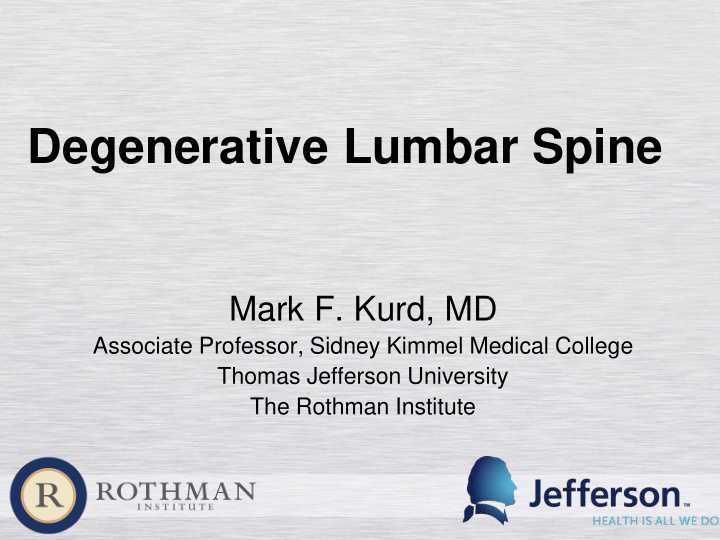



Degenerative Lumbar Spine Mark F. Kurd, MD Associate Professor, Sidney Kimmel Medical College Thomas Jefferson University The Rothman Institute
Disclosures • Duratap, LLC: Shareholder
History of Present Illness • CC: – 51 year old automotive plant employee, presents to the office with low back pain and a crooked spine • HPI: – Pain: sharp/constant predominately in upper lumbar midline – worse when walking and standing – Increasingly hunched over – Starting to use a cane for ambulating – Attempted TLSO brace and physical therapy – No bowel or bladder deficits – No leg/gluteal pain
Physical Examination • PE: – Lumbar EXT: 30 deg, FLEX: 45 deg – Left sided lumbar hump and global kyphotic deformity – Negative Long Tract Signs: Hoffmann’s Babinski’s, Reflexes, Clonus – Lower Extremity and Upper Extremity Strength 5/5 – Sensation is intact to pin prick from c4-T1 and L2-S1. – Negative Straight Leg raise bilaterally.
Radiographs
Radiographs
Evaluation Determine Pain Generator History PE Compensatory Mechanism Retrovert pelvis Flex Knees Hyperextend mobile spine Fixed vs. Flexible Imaging Radiographs: Balance MRI: Stenosis
Radiographic Evaluation – Sagittal Imbalance • 36 inch Lateral Long-Cassette • Identify key vertebral landmarks • Measure Sagittal Vertical Axis • Measure Pelvic Incidence • Measure Sacral Slope and Pelvic Tilt • Measure Lumbar Lordosis • Measure Thoracolumbar Sagittal Alignment • Measure Thoracic Kyphosis Joseph et al. J Am Acad Orthop Surg. 2009;17:378-388.
Spinopelvic Parameters • Pelvic Incidence is a Constant Anatomic Parameter • Sacral Slope and Pelvic Tilt are Position Dependant PI = SS + PT PI = LL +/- 9° Schwab et al. Spine. 2010. 35(25):2224-31. Legaye et al. Eur Spine J. 1998;7:99-103.
Radiographic Evaluation – Coronal Imbalance • 36 inch PA Long-Cassette • Measure the Fractional curve in the lumbosacral jxn • Find the apical vertebrae • Find the neutral vertebrae • Find the stable vertebrae • Measure the main curve Cobb angle • Measure the secondary curve Cobb angle • Measure trunk shift Tribus. J Am Acad Orthop Surg. 2003. 11:174-183.
Provocative Discography • 8 patients no previous LBP with previous ICBG for reasons other than lumbar surgery – Majority of patients unable to distinguish discogram pain from ICBG site pain. • “The ability of a patient to separate spinal from non-spinal sources of pain on discography is questioned”
Discography Most frequently used tool to diagnose discogenic LBP & select surgical candidates has High false positive rate Unproven benefit in predicting surgical outcomes
Algorithm for Back Pain Pain Generator Discogenic Deformity Stenosis Other Decompression/F Nonsurgical Sagittal Coronal Decompression usion PT NSAIDS ESI RFA
Algorithm for Sagittal Imbalance Sagittal Imbalance Fixed Flexible Anterior and Pedicle Subtraction Posterior Fusion with Osteotomy and Structural Grafting Decompression Anteriorly and where needed Decompression where needed Joseph et al. J Am Acad Orthop Surg. 2009. 17:378-388.
Sagittal Correction Goals Schwab et al. Spine. 2010. 35(25):2224-31.
Algorithm for Coronal Deformity Coronal Deformity Global Global Balance Imbalance/Trunk Shift Decompression/F Nonsurgical Stenosis usion c Correction Decompression/Fusi on
Conclusion • Diagnosis –Identify pain generator • Treatment –Nonsurgical –Surgical • Stenosis • Sagittal Imbalance – PI = LL +/- 9 deg • Coronal deformity with stenosis or trunk shift
Thank You
Recommend
More recommend